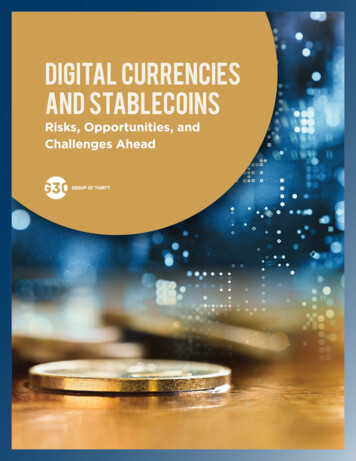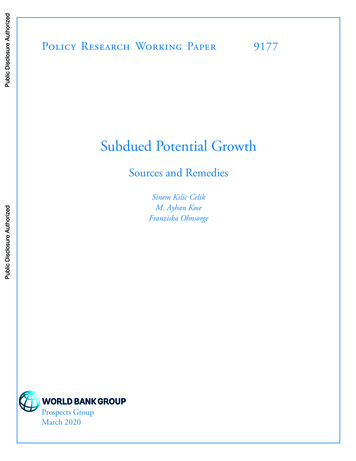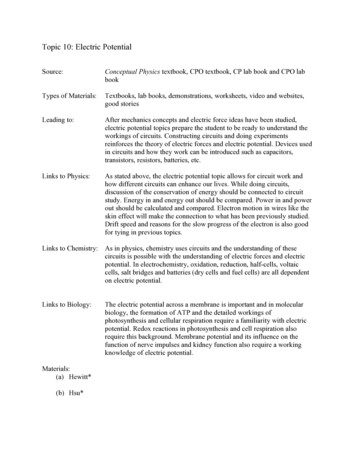
Transcription
Board of Governors of the Federal Reserve SystemInternational Finance Discussion PapersISSN 1073-2500 (Print)ISSN 2767-4509 (Online)Number 1334January 2022Stablecoins: Growth Potential and Impact on BankingGordon Y. Liao and John CaramichaelPlease cite this paper as:Liao, Gordon Y. and John Caramichael (2022). “Stablecoins: Growth Potential and Impact on Banking,” International Finance Discussion Papers 1334. Washington: Board ofGovernors of the Federal Reserve System, https://doi.org/10.17016/IFDP.2022.1334.NOTE: International Finance Discussion Papers (IFDPs) are preliminary materials circulated to stimulate discussion and critical comment. The analysis and conclusions set forth are those of the authors anddo not indicate concurrence by other members of the research staff or the Board of Governors. Referencesin publications to the International Finance Discussion Papers Series (other than acknowledgement) shouldbe cleared with the author(s) to protect the tentative character of these papers. Recent IFDPs are availableon the Web at www.federalreserve.gov/pubs/ifdp/. This paper can be downloaded without charge from theSocial Science Research Network electronic library at www.ssrn.com.
Stablecoins: Growth Potential and Impact on BankingGordon Liao *John Caramichael †January 2022AbstractStablecoins have experienced tremendous growth in the past year, servingas a possible breakthrough innovation in the future of payments. In this paper,we discuss the current use cases and growth opportunities of stablecoins, andwe analyze the potential for stablecoins to broadly impact the banking system.The impact of stablecoin adoption on traditional banking and credit provisioncan vary depending on the sources of inflow and the composition of stablecoinreserves. Among the various scenarios, a two-tiered banking system can bothsupport stablecoin issuance and maintain traditional forms of credit creation.In contrast, a narrow bank approach for digital currencies can lead to disintermediation of traditional banking, but may provide the most stable peg to fiatcurrencies. Additionally, dollar-pegged stablecoins backed by adequately safeand liquid collateral can potentially serve as a digital safe haven currency during periods of crypto market distress.Keywords: Stablecoins, Digital currencies, Credit intermediation, Banking, Systemic risk, Fintech, Financial innovation, Payment systemJEL Classifications: E40, E50, F33, G10, G20, O30* Liao: When this paper was written, Liao was a Senior Economist at the Board of Governors of the FederalReserve System. Email:gliao@post.harvard.edu†Caramichael: Board of Governors of the Federal Reserve System. Email: john.caramichael@frb.gov.We thank Shaghil Ahmed, Brett Berger, Jorge Herrada, Alex Lee, Peter Lone, Yi Sun, Frank Warnock, MarkVan Der Weide, Paul Wong, Jeff Zhang, members of the Federal Reserve Board Technology Lab in the Division of Reserve Bank Operations and Payment Systems, and participants at the Federal Reserve InternationalFinance Workshop for helpful feedback. The views expressed in this paper are solely the responsibility of theauthors and should not be interpreted as reflecting the views of the Board of Governors of the Federal ReserveSystem or of any other person associated with the Federal Reserve System. First draft: May 2021. Final draft:September 2021.
Stablecoins are digital currencies that peg their value to an external reference, typicallythe U.S. dollar (USD). Stablecoins play a key role in digital markets, and their growthcould spur innovations in the broader economy. In the past year, USD-pegged stablecoinscirculating on public blockchains have seen explosive growth, with a combined circulatingsupply of nearly 130 billion as of September 2021 – a more than 500% increase from oneyear ago.As stablecoins gain increasing attention in public discourse, a host of issues have beenraised, including the stability of their pegs, consumer protection, know-your-customerand anti-money laundering compliance, and the scalability and efficiency of settlements.1In this note, we focus our discussion on the potential impact of stablecoins on the banking system and credit intermediation.2 While a range of stablecoin-related issues maybe resolved with appropriate institutional safeguards, regulations, and technical advancements, sustained growth in stablecoins in circulation would ultimately impact the traditional banking system in significant ways that are important to understand.In this note, we first discuss the basics of stablecoins, their current use cases, and theirgrowth potential. Second, we study historical behaviors of stablecoins during past episodesof crypto and broad financial market distress. We find that dollar-pegged stablecoins haveexhibited safe asset qualities in that their prices in the secondary market temporarily riseabove the peg during times of extreme market distress, incentivizing the issuance of morestablecoins. We also highlight the risk of a ”run” on certain stablecoins that are backed bynon-cash-equivalent risky assets.Finally, we outline possible scenarios for bank reserves, credit intermediation, and central bank balance sheets should stablecoins gain broader traction. Our research suggeststhe broad adoption of asset-backed stablecoins can potentially be supported within a twotiered, fractional reserve banking system without a negative impact on credit intermediation. In such a framework, stablecoin reserves are held as commercial bank deposits,and commercial banks engage in fractional reserve lending and maturity transformationas they normally would with traditional bank deposits.3 We also find that the replacementof physical cash (banknotes) with stablecoins could result in more credit intermediation.In contrast, a narrow banking framework, in which stablecoin issuers are required to backtheir stablecoins with central bank reserves, minimizes the risk of ”runs” on stablecoinsbut can potentially reduce credit intermediation.1Among the various issues associated with stablecoin adoption and regulations, the stability and “run risk”are of primary concern. See Gorton and Zhang (2021) for a discussion of regulatory safeguards surroundingstablecoins.2This paper does not consider all potential impacts of stablecoins on the banking system. For example,several key areas remain unexplored, such as changes to leverage ratios; liquidity coverage and the run rateof different forms of bank deposits; net stable funding ratios; the distribution of deposits and reserves acrossbanks; the challenges of know-your-customer and anti-money laundering policies; and the transmission ofmonetary policy.3This necessarily assumes that stablecoin deposits are treated similarly as transactional deposits for liquidity management, depository insurance, and regulatory purposes.1
I.The basics of stablecoinsStablecoins are digital currencies recorded on distributed ledger technologies (DLTs), usually blockchains, that are pegged to a reference value.4 The majority of outstanding stablecoins are pegged to the U.S. dollar, but stablecoins can also be pegged to other fiatcurrencies, baskets of currencies, other cryptocurrencies, or commodities such as gold.Stablecoins serve as a store of value and a medium of exchange on DLTs, which enablestablecoins to be exchanged or integrated with other digital assets.Stablecoins differ from traditional digital records of money, such as bank deposit accounts,in two primary ways. First, stablecoins are cryptographically secured. This allows usersto settle transactions near-instantaneously without double-spending or an intermediarythat facilitates settlements. On public blockchains, this also allows for 24-hours-a-day/7days-a-week/365-days-a-year transactions.5 Second, stablecoins are typically built on DLTstandards that are programmable and allow for the composability of services.6 In thiscontext, “composability” means stablecoins can function as self-contained building blocksthat interoperate with smart contracts (self-executing programmable con
Stablecoins serve as a store of value and a medium of exchange on DLTs, which enable stablecoins to be exchanged or integrated with other digital assets. Stablecoins differ from traditional digital records of money, such as bank deposit accounts, in two primary ways. First, stablecoins are cryptographically secured. This allows users







![2 CHAPTER 1 [Topic 1] Coulomb's law, electrostatic field and electric .](/img/52/physics.jpg)


